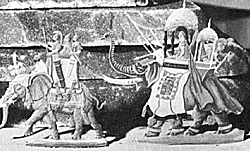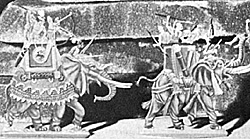
Photo: Michael Hitrovo's war elephants
The big fellow in the picture above (the one with the big nose) is Hannibal, named, of course, after the famous Carthegenian who was so fond of elephants. Hannibal is my elephant. The function of whom will be explained later.
Elephants in ancient warfare have a rather chequered history, achieving remarkable successes in some cases, dismal failures in others. Since most wargamers cite historical precedents when they make up rules, elephants always cause trouble (their historic role) and lead to disagreement. With this in mind, I shall enter my own views on the subject, anticipating as I do the barbs of critics.
The elephant makes his greatest splash in ancient history through his role as an opponent of the Romans under the direction of Phyrrus, Hamilcar, and Hannibal. Elephants, however, have formed the dominant portions of some armies such as the Khmer Empire in Siam, have figured prominently in the armies of China and the Indian subcontinent. Most of the latter named nations employed Indian Elephants (Dephas Maximus Indians), but Hannibal is believed to have used African Elephants (Loxodanta Africana).
Elephants are the largest of domesticated animals, so it is only natural that man should seek to employ them in warfare-natural to man, not elephants. Elephants, unless personally angry, don't like to step on soft, squishy things (like people, for instance) nor do they like to be stuck with spears, arrows, and other implements. Horses share an of these attributes, but are noticeably less intelligent, therefore more easily talked into doing things against their better judgment.
The greatest weapon of the elephant and its greatest weakness, was terror, arising from the fears of men and (especially) horses on the one hand and fears of elephants on the other. A well trained horse may ride down the throat of a cannon; but if he hasn't seen an elephant, you'll never be able to convince him on the spur of the moment that those big things don't eat horses. FIephants got into Hellenistic warfare in a big way by frightening the horses of Demetrius Poliocertes. The elephants (200 each) simply formed a line at great intervals and stood there, and the horses wouldn't go near them.
Similar things happened to the Roman cavalry against Phyrrus Alexander's cavalry at the Indus and other peoples' cavalry here an~ there.
Elephants also distinguished themselves whenever someone succeeded in cutting them off from their own army and surrounding them. A surrounded elephant has usually ceased to wonder whether he should allow himself to be dragged into a quarrel between ferocious pygmies-he is in, and there is no way out except to step on people (few elephants stepped on horses due to the precaution taken by the latter to prevent it).
 Photo: Two war elephants from the
famous collection of Michael Hitrovo. Elephants,
by the way, who are really quite as peaceful
(though better painted) as Hannibal since
Michael isn't a wargamer.
Photo: Two war elephants from the
famous collection of Michael Hitrovo. Elephants,
by the way, who are really quite as peaceful
(though better painted) as Hannibal since
Michael isn't a wargamer.
Elephants also charged and routed Hannibal's cavalry at Zama, bringing about his final defeat. These elephants were Hannibal's own, for while the Romans were willing, if necessary, to face elephants in battle, they did not see fit to add to their troubles by bringing their own. Scipio simply formed his legions in maniple columns rather than chequered formations (so as not to confuse the elephants) and sent his light troops up and down the intervals chasing elephants. Given a choice, practically all elephants orefer to go through open spaces rather than charge the heads of columns. When most of the men on the elephants had been picked off, and the elephants were stung by missile fire, they turned and headed for the Carthagenians. Their way was blocked by a dense mass of infantry, so they went around, driving the Carthagenian cavalry off the field. The Numidian cavalry (Roman allies) fell ini with the pack and chased it for several miles.
After that, the battle continued quite some time, not ending until the Numidians returned to fall on the Carthagenian flank and rear. It is difficult to see how Hannibal could have dropped that one without elephants, in spite of the clurnsiest battle plan of his career.
Aeneus the Tactician, an ancient student of warfare, had this to say of the place of elephants in the army:
- .... there are three branches of the mounted force: the first is cavalry,
the second furnished with chariots, the third with elephants, but let the
consideration of chariots and elephants, since they are not naturally well
adapted for fighting purposes, be deferred to a later time, and we shall discuss
the cavalry since it is much employed and on many occasions more useful in
battles.
The late Will Cuppy, author of "The Decline and Fall of Practically Everybody" was at least that skeptical of the military value of elephants, to which he properly attributes the destruction of Hannibal. He mentioned that Hannibal did better when he was out of elephants and recommends to anyone planning to take an animal along over the Alps, the substitution of chamois, which are far better suited for it than elephants.
Some will think that I have something against elephants. On the contrary, it will be seen from the function of Hannibal (my elephant) that I have the best interests of elephants at heart.
Many ancient wargame rules have two sets of rules dealing with morale of men and horses facing elephants. If the army contains elephants habitually, its horses and men are relatively unafraid, if not, panic! This system is indeed well founded, so my army contains at least one elephant. The photo, of course, was staged-Hannibal is a non-combatant. He is posted to the cavalry remount depot, Where he grazes among the horses and performs odd jobs. Elephants, so far as I can tell, enjoy grazing and prefer the company of smaller animals to solitude. Hannibal understands, of course, that if he steps on any horses he will immediately be posted on the front.
Back to The Armchair General Vol. 1 No. 6 Table of Contents
Back to The Armchair General List of Issues
Back to MagWeb Master Magazine List
© Copyright 1968 by Pat Condray
This article appears in MagWeb (Magazine Web) on the Internet World Wide Web. Other military history articles and gaming articles are available at http://www.magweb.com
